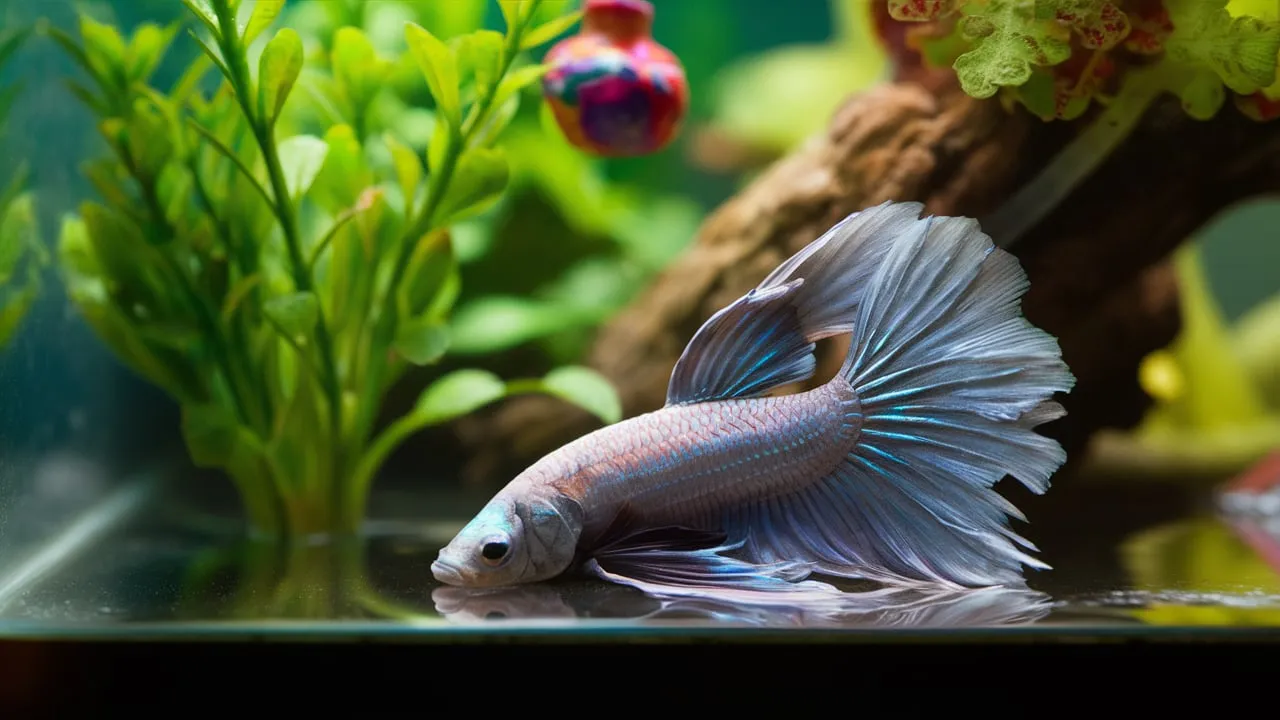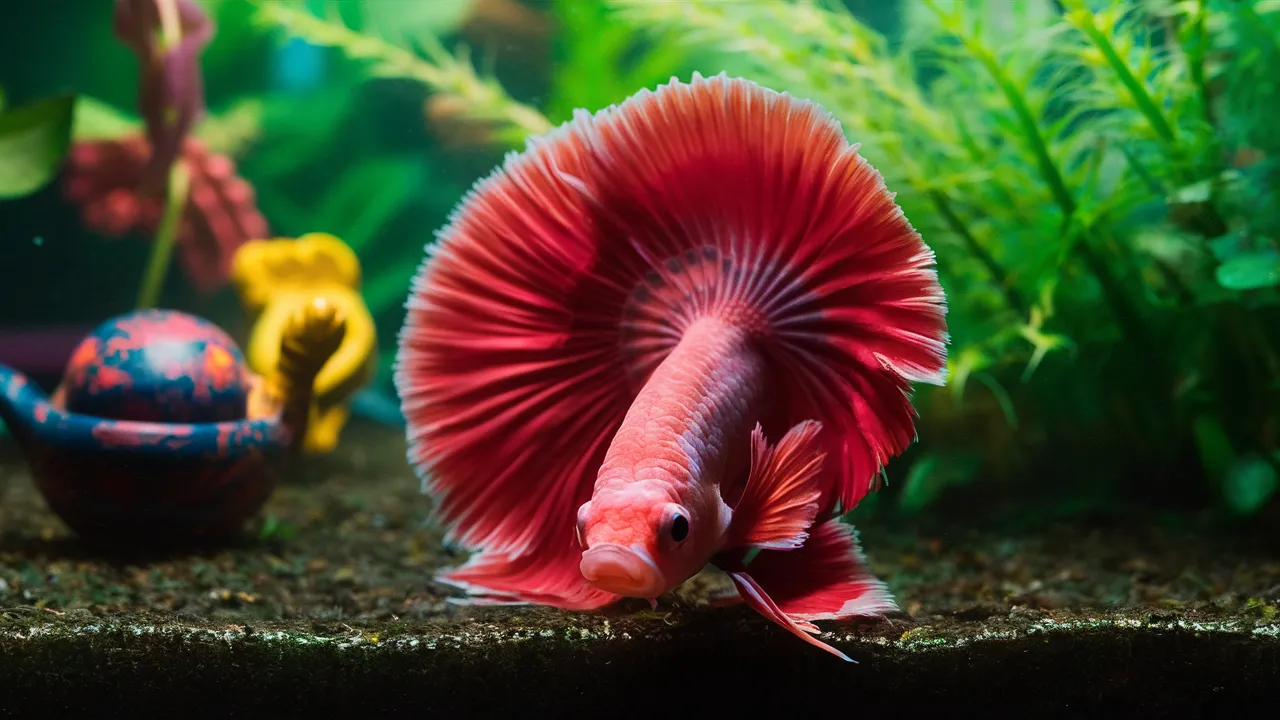While bettas are known for their occasional stillness, a Betta Fish Laying At Bottom Of Tank often signals an underlying issue.
This comprehensive Betta Fish Guide aims to help you understand why your betta might be exhibiting this behavior and what steps you can take to address it.
Understanding Normal Betta Behavior
Before we delve into the potential problems, it’s important to understand what constitutes normal betta behavior. Bettas are anabantoids, meaning they can breathe air directly from the surface. This ability allows them to inhabit low-oxygen environments in the wild. As a result, it’s not uncommon to see your betta resting near the bottom of the tank, taking short naps, or even “sleeping” with their fins still.
However, if your betta is consistently laying on the bottom and displays other unusual behaviors like loss of appetite, lethargy, or changes in coloration, it’s time to investigate further.

Betta Fish Laying At Bottom Of Tank: Causes And Solutions
Poor Water Quality
The most common culprit behind unusual betta behavior, including betta fish laying at the bottom of the tank, is poor water quality. Ammonia, nitrites, and nitrates, all byproducts of fish waste, can build up in the tank and become toxic to your betta.
- Symptoms: Aside from lethargy and bottom-dwelling, poor water quality can manifest as rapid gill movement, gasping for air at the surface, fin clamping, and loss of appetite.
- Solutions:
- Test Your Water: Regularly test your tank water for ammonia, nitrite, and nitrate levels using a reliable aquarium test kit.
- Partial Water Changes: Perform a 25% water change at least once a week, and up to 50% if your test results indicate high levels of toxins.
- Proper Filtration: Ensure your tank has an appropriate filter running at all times to help remove waste and maintain water quality.
Incorrect Water Temperature
Bettas are tropical fish, thriving in temperatures between 78-82°F (25-28°C). Water that’s too cold or too hot can stress your betta, leading to a weakened immune system and lethargy.
-
Symptoms: In cold water, bettas become sluggish and may lay at the bottom. In water that’s too warm, you might notice rapid breathing, lethargy, and loss of appetite.
-
Solutions:
-
Use a Thermometer: Monitor your tank’s temperature consistently using an aquarium thermometer.
-
Aquarium Heater: Invest in a reliable aquarium heater with a thermostat to maintain a stable water temperature within the ideal range.
-
Swim Bladder Disease
Swim bladder disease is a common ailment in bettas, affecting their buoyancy and ability to swim properly. It can cause them to float at the surface, sink to the bottom, swim sideways, or have difficulty maintaining balance.
- Symptoms: Look for unusual swimming patterns, difficulty staying upright, or a bloated belly.
- Solutions:
- Fasting: Start by fasting your betta for 1-2 days to help reduce bloating and pressure on the swim bladder.
- High-Fiber Foods: After fasting, offer high-fiber foods like daphnia or blanched peas to aid digestion.
- Consult a Vet: If symptoms persist, consult an aquatic veterinarian, as swim bladder disease can sometimes be caused by bacterial infections requiring medication.

Stress and Boredom
Bettas are intelligent creatures that need mental and physical stimulation. A bare, small tank can lead to stress and boredom, causing them to become inactive and lay at the bottom.
- Symptoms: Along with inactivity, a stressed betta might display fin clamping, loss of appetite, and color fading.
- Solutions:
- Enrich the Environment: Provide a stimulating environment with plants (live or silk), caves, rocks, and other decorations to create hiding spots and exploration opportunities.
- Appropriate Tank Size: Ensure your betta has a spacious tank, ideally 5 gallons or larger.
- Interactive Activities: Engage your betta with activities like mirror reflections (in moderation), floating ping pong balls, or betta-safe toys.
Illness or Parasites
Various illnesses and parasitic infections can cause lethargy and bottom-dwelling in bettas.
- Symptoms: Watch for additional symptoms like white spots on the body or fins (Ich), fin rot, velvet disease (a velvety-looking film on the body), or unusual lumps or bumps.
- Solutions:
- Quarantine: If you suspect illness, immediately quarantine your betta to a separate tank to prevent the spread of any potential diseases.
- Consult a Vet: It’s essential to consult an aquatic veterinarian for proper diagnosis and treatment. They can recommend appropriate medications or treatments based on the specific illness or parasite.
Old Age
As bettas age, they naturally become less active and may spend more time resting at the bottom of the tank.
- Symptoms: Along with decreased activity, an aging betta might show signs like faded coloration, reduced appetite, and cloudy eyes.
- Solutions:
- Provide Comfort: Ensure their tank is clean, the water quality is pristine, and their environment is stress-free.
- Adjust Feeding: Offer smaller, more frequent meals to accommodate their slower metabolism.
Conclusion
Observing your betta fish laying at the bottom of the tank can be a worrying experience. However, by understanding the potential causes and taking prompt action, you can significantly improve your betta’s chances of a full recovery.
Remember, maintaining a clean and stimulating environment, monitoring water parameters, and providing a balanced diet are crucial elements of responsible betta care. When in doubt, always consult a qualified aquatic veterinarian for expert advice and treatment.

Related Posts
Culture Of Infusoria In The Tank: A Microscopic Feast for Fry
Almond Leaf For Betta: A Natural Habitat Enhancer
Clamped Fins On Betta: Causes & Treatment